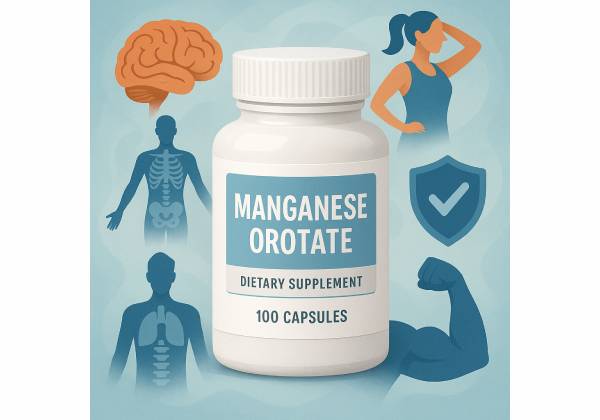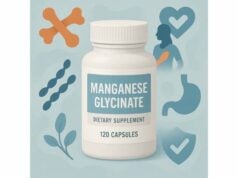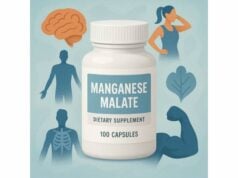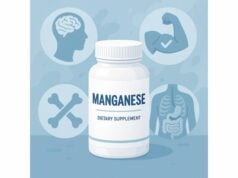
Manganese orotate is a supplemental form of manganese in which the essential trace mineral is paired with orotic acid (a naturally occurring compound involved in nucleotide metabolism). Like other manganese salts, it dissolves in the gut to release manganese ions that the body can absorb in small amounts and route to tissues, where manganese serves as a cofactor for key enzymes. People consider manganese orotate to support antioxidant defenses (via mitochondrial manganese superoxide dismutase), connective tissue and bone formation, and normal metabolism. Because most adults already reach daily manganese needs through food, manganese orotate is best used as a top-up rather than a high-dose intervention. Marketing sometimes suggests that “orotate” forms are uniquely bioavailable or “target tissues,” but real-world human evidence does not confirm clear superiority over other common salts at equivalent elemental doses. The practical focus should be on safe totals, thoughtful timing with other minerals and medications, and medical scenarios where manganese should be avoided. This guide gives you plain-spoken answers: what manganese orotate can and cannot do, how to dose it, who should steer clear, and how to evaluate your overall intake from diet and supplements.
Key Insights
- Supports mitochondrial antioxidant enzyme activity and connective tissue formation; benefits mainly ensure adequacy, not “extra performance.”
- Typical supplement add-on: 0.5–3 mg elemental manganese per day; count total from diet, water, and products.
- Keep total daily manganese below conservative adult ceilings; chronic excess may be neurotoxic, especially with impaired bile flow.
- Avoid self-supplementation if you have liver or biliary disease, documented iron deficiency, or occupational manganese exposure.
Table of Contents
- What is manganese orotate and how it works
- Benefits: where it may help and where it will not
- How to dose and when to take it
- Factors that change absorption and effectiveness
- Safety, side effects, and who should avoid
- Evidence snapshot and practical verdict
What is manganese orotate and how it works
Manganese is an essential trace mineral found in whole grains, legumes, nuts, leafy vegetables, coffee, and tea. In your body, it acts as a catalyst: manganese ions activate enzymes that help convert macronutrients into energy, neutralize reactive oxygen species inside mitochondria, and build the proteoglycans that give cartilage bounce and bone its resilient matrix. Manganese also participates in normal blood clotting and supports enzymes like arginase and pyruvate carboxylase.
Manganese orotate couples manganese with orotic acid, forming a neutral salt. In the small intestine the salt dissociates, releasing manganese and orotate. The manganese is the active mineral; the orotate portion is largely a carrier at typical supplement doses. You may see claims that orotate salts cross cell membranes more readily or “deliver” minerals to specific tissues. For manganese in humans, rigorous head-to-head data demonstrating that orotate outperforms other forms (such as gluconate, citrate, sulfate, or glycinate) are lacking. Real-world outcomes depend much more on elemental dose, total daily intake from all sources, and individual physiology than on the specific anion attached to the mineral.
The body contains only a few dozen milligrams of manganese in total—about a quarter to two-fifths in bone—with the rest distributed across liver and other tissues. Intestinal absorption is intentionally low (often only a few percent), and the liver excretes most excess via bile. That homeostasis keeps levels steady in healthy adults, but it also means that people with cholestasis or other biliary problems are at higher risk of manganese accumulation.
Why consider a supplement at all? Some multivitamins provide little or no manganese; some diets skimp on whole grains, legumes, nuts, and tea; and certain clinician-guided bone or joint formulas include small amounts of manganese to support matrix enzymes. In these scenarios, manganese orotate can be a well-tolerated way to fill a gap—not to push high doses.
Key point: when reading labels, focus on elemental manganese (the amount of manganese ions) rather than the weight of “manganese orotate.” The elemental number determines both physiological effect and your daily total.
Benefits: where it may help and where it will not
Antioxidant defense inside mitochondria. Manganese is the metal cofactor for mitochondrial manganese superoxide dismutase (MnSOD), the first responder against superoxide radicals generated during normal energy production. Ensuring adequate manganese supports this system. However, once MnSOD has enough cofactor, more manganese does not create “extra” antioxidant capacity. The aim is adequacy—nothing heroic.
Connective tissue and bone matrix. Manganese-dependent glycosyltransferases help build proteoglycans and collagen scaffolding in cartilage and bone. In animal models, low manganese impairs skeletal development and wound repair; in humans, signals are subtler and often tied to overall diet quality. That is why many bone and joint formulas include modest manganese alongside vitamin D, vitamin K, calcium, magnesium, zinc, copper, and boron. Manganese acts as a supporting member of the ensemble—rarely the star.
Energy and metabolism. Manganese participates in carbohydrate and lipid pathways and supports arginase in the urea cycle. These mechanistic roles are essential, yet they do not mean manganese orotate boosts energy in the way stimulants do. Claims that “orotate = energy” hinge on the malate/citrate style narrative applied to orotate; at the tiny amounts contained in trace-mineral supplements, orotate does not meaningfully drive the Krebs cycle. Expect quiet cofactor support, not a surge.
Glucose and lipid outcomes. Observational studies sometimes link manganese status with glycemic or lipid markers, but these biomarkers often reflect exposure rather than functional sufficiency, and findings vary across populations. Robust trials do not show manganese supplements improving blood sugar or cholesterol in otherwise well-nourished adults. Diet, activity, sleep, and medications remain the primary levers.
Who might notice practical benefits?
- People on highly refined diets with very few whole grains, legumes, nuts, or tea.
- Individuals using minimalist multivitamins lacking manganese who prefer a small, measured add-on.
- Patients on restricted medical diets or specialized nutrition support under clinician guidance.
What manganese orotate will not do. It is not a direct pain reliever for joints, a cognitive enhancer, a fat burner, or an athletic performance booster when added to an adequate diet. If you feel an effect after starting a multi-ingredient product, it is more likely due to other actives (for example, magnesium, caffeine from botanicals, or B-vitamins) than to manganese itself.
Bottom line: manganese orotate helps most when it brings inadequate intake back to normal. Beyond that, extra does not equal better and may increase risk.
How to dose and when to take it
Know your targets. Adult adequacy targets from all sources (diet plus supplements) are commonly set around 2.3 mg/day for men and 1.8 mg/day for women. Many mixed diets already provide 2–6 mg/day from food alone. Authorities also recommend conservative safe levels for chronic daily intake—treat these as ceilings, not goals. A practical rule for healthy adults is to keep total daily manganese at or below 8–11 mg/day, depending on your region’s guidance.
Pragmatic supplement ranges.
- Top-up dosing: 0.5–2 mg elemental manganese per day is sufficient for most adults who want insurance when diet is limited.
- Multivitamin users: If your multi provides 1–2.3 mg, additional manganese is rarely needed.
- Single-ingredient capsules: These often supply 5–10 mg or more per serving—amounts that can quickly push your total toward ceilings once food and other products are included. Unless a clinician advises, avoid high-dose stand-alone manganese.
Elemental matters, not the salt weight. The label should read “Manganese (as manganese orotate) … mg.” Add that elemental number to your daily total. Disregard claims that a heavier “orotate complex” weight implies more active mineral.
Timing and with-meal strategy.
- Take manganese orotate with food to reduce the chance of stomach upset and to mirror how manganese arrives in the body via meals.
- If you also take iron or calcium, separate doses across the day—these minerals can compete for intestinal transport.
- If you need certain antibiotics (tetracyclines, fluoroquinolones), do not take manganese near those doses (details below).
Duration of use. Think in defined blocks—for example, 8–12 weeks when your diet is constrained—then reassess. If your everyday menu routinely includes oats, brown rice, beans, nuts, and tea, you probably do not need a long-term stand-alone manganese supplement.
Special life stages and scenarios.
- Pregnancy and lactation: Needs are modestly higher but typically covered by standard prenatal formulas. Avoid stacking a separate manganese product unless your clinician recommends it.
- Children and adolescents: Do not supplement manganese outside of pediatric guidance.
- Athletes: There is no credible evidence that manganese above adequacy improves VO₂ max, strength, or recovery. Emphasize iron status, protein intake, and overall diet quality instead.
Mini checklists.
- If your multi has 2 mg manganese and you eat nuts and whole grains most days, skip extra manganese.
- If you eat a very refined diet and take no multi, consider 1 mg/day while improving food choices.
- If you drink several cups of tea daily (a meaningful manganese source) and already take a bone formula with 2–4 mg, adding manganese orotate is usually unnecessary.
Factors that change absorption and effectiveness
Self-regulation in the gut and liver. The intestine absorbs a small fraction of ingested manganese and throttles uptake up or down based on status. When intakes rise, absorption falls; when intakes drop, absorption rises. The liver then excretes excess via bile. This two-step control protects against overload in healthy adults but can fail in cholestasis or other biliary disorders.
Iron status can amplify uptake. Iron and manganese share certain transport pathways. When iron stores are low, the body up-regulates these transporters, which can increase manganese absorption from the same oral dose. If you are treating iron deficiency, keep manganese intake conservative, separate dosed minerals, and revisit the plan once iron is replete.
Diet pattern and beverages.
- Tea and coffee contribute manganese (tea especially). Polyphenols in these drinks can reduce immediate mineral absorption, but habitual tea drinkers typically meet manganese needs through diet regardless. If you take a manganese pill, consider swallowing it with water at a meal rather than with tea.
- Phytate and fiber in bran and legumes bind minerals, yet because manganese requirements are low and these foods often contain manganese, mixed diets still supply enough for most adults.
Other minerals compete. Large single doses of calcium, iron, magnesium, or zinc can crowd each other in the gut. If you take several minerals, split them—say iron in the morning, a multivitamin with manganese at dinner—to avoid avoidable interference.
Orotate vs other salts. Despite popular claims, human data do not show manganese orotate to be uniquely better than gluconate, citrate, sulfate, or glycinate at equivalent elemental dosing. Choose based on tolerability, transparent labeling, and how a product fits your overall stack rather than on the premise of special delivery.
Health conditions that shift the risk–benefit balance.
- Liver or biliary disease: Reduced bile flow means reduced manganese excretion and higher risk of accumulation; avoid discretionary manganese.
- Infants and young children: They absorb a higher fraction than adults and have lower safe thresholds; avoid non-essential manganese supplements.
- Occupational exposure: Welders and others exposed to airborne manganese should not add supplemental manganese without specialist guidance.
Environment counts. Private wells can contain measurable manganese. If you rely on well water—especially with infants at home or if several household members take multi-mineral products—consider a simple water analysis to understand baseline exposure.
Tolerability tweaks. If manganese orotate causes mild nausea, take it in the middle of a meal or step down to a lower elemental dose. Often, discomfort reflects tablet binders or capsule size rather than manganese itself; a different brand can help.
Safety, side effects, and who should avoid
Manganese is essential, but like many metals, chronic excess—especially with impaired excretion—can be harmful. Understanding realistic risks keeps supplementation safe.
Typical tolerability. At low doses with food (for example, 0.5–2 mg/day elemental), most adults notice no effects. Occasional users report mild stomach upset if taking minerals on an empty stomach; food usually solves this.
Neurological risk with overexposure. The chief safety concern is manganese accumulation in the brain over time, particularly in the basal ganglia, leading to parkinsonian features (slowness, rigidity, tremor, gait changes). This is best documented in occupational inhalation but can occur orally when total intake is high or excretion is impaired. The practical guardrails are straightforward: do not exceed conservative ceilings, do not stack multiple manganese-containing products, and avoid supplements altogether if biliary excretion is compromised.
Upper bounds to respect. Treat 8–11 mg/day (diet + supplements) as a ceiling for chronic daily intake in healthy adults, consistent with recent risk assessments. Remember that food often supplies several milligrams, and beverages like tea contribute meaningfully.
Medication interactions you must plan around.
- Tetracyclines and fluoroquinolones: Manganese and other polyvalent minerals chelate these antibiotics and block their absorption. Separate by a generous window—commonly at least 2 hours before or 4–6 hours after the antibiotic dose, per pharmacy instructions.
- Iron therapy: Large iron doses compete with manganese for transport; take at different times, and keep manganese low while iron deficiency is corrected.
- Levodopa and some thyroid medicines: Minerals can reduce absorption; follow your clinician’s timing guidance for all mineral supplements.
Who should avoid self-supplementation (unless prescribed and monitored).
- Chronic liver or biliary disease, including cholestasis.
- Parkinsonism or other movement disorders.
- Occupational manganese exposure (e.g., welding) or known environmental overexposure.
- Infants and children outside of clinician-directed care.
- Iron deficiency until iron status is corrected and a clinician green-lights manganese.
Warning signs to act on. New neurological changes (slowed movements, tremor, balance problems), persistent headaches, mood shifts, or sleep disturbance in the context of high mineral intake warrant medical review and an inventory of total manganese exposure, including water and workplace.
Quality and labeling matter. Choose brands that clearly state elemental manganese and the form (“as manganese orotate”), avoid proprietary blends that obscure dose, and prefer products with third-party testing for identity and purity.
Practical rule set: food first, dose low, count totals, separate from interacting medicines, and reassess regularly—especially if your health status or medication list changes.
Evidence snapshot and practical verdict
Dietary sufficiency is common. Surveys in Europe and the Nordics consistently place typical adult manganese intake between 2 and 6 mg/day from food alone, with major contributors including whole grains, legumes, nuts, tea, coffee, and spices. That reality explains why frank deficiency is uncommon in free-living adults and why supplementation should target gaps, not exceedance.
Form comparisons: claims outpace data. For manganese, high-quality human trials comparing orotate with gluconate, citrate, sulfate, or glycinate are limited. Health-professional resources emphasize that elemental dose and total exposure dominate outcomes; the specific anion (orotate vs others) has no proven clinical advantage at equivalent doses. Orotate may be well tolerated, but superiority claims are not substantiated.
Core biology is settled; clinical add-ons are modest. Manganese is indispensable for mitochondrial MnSOD and for enzymes that build cartilage and bone matrix. These roles justify low-dose manganese in some bone/joint blends—but do not support manganese as a stand-alone therapy for osteoporosis, metabolic disease, or athletic performance in otherwise well-nourished adults.
Safety lens: brain and bile. The most consequential risk from chronic excess is neurological, particularly in individuals with impaired biliary excretion or significant environmental/occupational exposure. Recent European risk assessments explicitly adopted a conservative safe intake approach for chronic exposure because human dose–response data remain uncertain. The take-home is pragmatic: aim well below ceilings for long-term daily use.
Medication interactions are real and preventable. Polyvalent minerals—including manganese—chelate certain antibiotics and reduce their absorption. Dose separation is a simple, high-value habit during short antibiotic courses.
Verdict for people-first decisions.
- If your diet is varied, you probably do not need manganese orotate.
- If you do supplement, choose small elemental doses (often 0.5–2 mg/day), count total intake, and set a time-boxed trial.
- Avoid manganese supplements entirely with liver or biliary disease, during iron deficiency treatment, or with occupational exposure unless a specialist advises otherwise.
- Treat “orotate” as a formulation choice for tolerability—not as a license to take more.
Your best long-term strategy is simple: food first, low dose, and periodic review.
References
- Manganese – Health Professional Fact Sheet 2021 (Guideline)
- Scientific opinion on the tolerable upper intake level for manganese 2023 (Guideline)
- Manganese – a scoping review for Nordic Nutrition Recommendations 2023 2024 (Systematic Review)
- Manganese-Induced Parkinsonism: Evidence from Epidemiological and Experimental Studies 2023 (Systematic Review)
- Multivalent cations interactions with fluoroquinolones or tetracyclines: A cross-sectional study 2021 (Observational Study)
Disclaimer
This article provides general information about manganese orotate and is not a substitute for professional medical advice, diagnosis, or treatment. Always consult a qualified healthcare professional before starting, stopping, or changing any supplement—especially if you are pregnant or breastfeeding; have liver, biliary, neurological, or iron-related conditions; take prescription medications; or are considering doses above those typically found in multivitamins. If you notice new neurological symptoms or other concerning effects while using manganese, stop the supplement and seek medical care.
If this guide helped you, please consider sharing it on Facebook, X (formerly Twitter), or your preferred platform, and follow us for future evidence-based articles. Your support helps us continue producing high-quality, people-first content.










